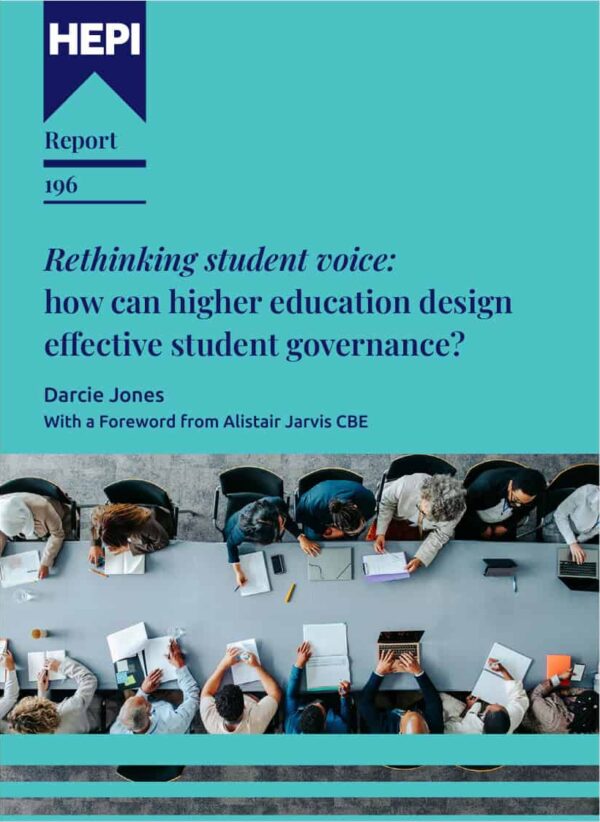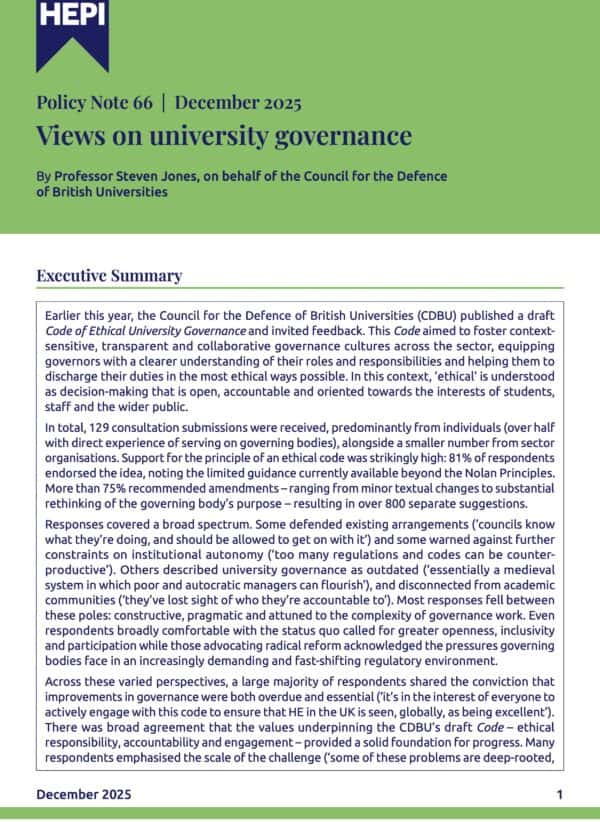Beyond Rankings: Redefining University Success in the AI-Era
By Somayeh Aghnia, Co-Founder and Chair of the Board of Governors at the London School of Innovation.
University rankings have long been a trusted, if controversial, proxy for quality. Students use them to decide where to study. Policymakers use them to shape funding. Universities use them to benchmark themselves against competitors. But in an AI-powered world, are these rankings still measuring what matters?
If we’ve learned anything from the world of business over the last decade, it’s this: measuring the wrong things can lead even the most successful organisations astray. The tech industry, in particular, has seen numerous examples of companies optimising for vanity metrics (likes, downloads, growth at all costs) only to realise too late that these metrics didn’t align with real value creation.
The metrics we choose to measure today will shape the universities we get tomorrow.
The Problem with Today’s Rankings
Current university ranking systems, whether national or global, tend to rely on a familiar set of indicators:
- Research volume and citations
- Academic and employer reputation surveys
- Faculty-student ratios
- International staff and student presence
- Graduate salary data
- Student satisfaction and completion rates
While these factors offer a snapshot of institutional performance, they often fail to reflect the complex reality of the world. A university may rise in the rankings even as it fails to respond to student needs, workforce realities, or societal challenges.
For example, graduate salary data may tell us something about economic outcomes, but very little about the long-term adaptability or purpose-driven success of those graduates or their impact on improving society. Research citations measure academic influence, but not whether the research is solving real-world problems. Reputation surveys tend to reward legacy and visibility, not innovation or inclusivity.
In short, they anchor universities to a model optimised for the industrial era, not the intelligence era.
Ready for the AI paradigm?
Artificial Intelligence is a paradigm shift that is changing what we value in all aspects of life including education, especially higher education, how we define learning, what we want as an outcome, and how we measure success.
In a world where knowledge is increasingly accessible, and where intelligent systems can generate information, summarise research, and tutor students, the role of a university shifts from delivering knowledge or developing skills to curating learning experiences focusing on developing humans’ adaptability, and preparing students, and society, for uncertainty.
This means the university of the future must focus less on scale, tradition, and prestige, and more on relevance, adaptability, and ethical leadership. These are harder to measure, but far more important.
This demands a new value system. And with that, a new approach to how we assess institutional success.
What Should We Be Measuring?
As we rethink what universities are for, we must also rethink how we assess their impact. Inspired by the “measure what matters” philosophy from business strategy, we need new metrics that reflect AI-era priorities. These could include:
1. Adaptability: How quickly and responsibly does an institution respond to societal, technological, and labour market shifts? This could be measured by:
- Curriculum renewal cycle: Time between major curriculum updates in response to new tech or societal trends.
- New programme launches: Number and relevance of AI-, climate-, or digital economy-related courses introduced in the last 3 years.
- Agility audits: Internal audits of response times to regulatory or industry change (e.g., how quickly AI ethics is integrated into professional courses).
- Employer co-designed modules: % of programmes co-developed with industry or public sector partners.
2. Student agency: Are students empowered to shape their own learning paths, engage with interdisciplinary challenges, and co-create knowledge? This could be measured by:
- Interdisciplinary enrolment: % of students engaged in flexible, cross-departmental study pathways.
- Student-designed modules/projects: Number of modules that allow student-led curriculum or research projects.
- Participation in governance: % of students involved in academic boards, curriculum design panels, or innovation hubs.
- Satisfaction with personalisation: Student survey responses (e.g., NSS, internal pulse surveys) on flexibility and autonomy in learning.
3. AI and digital literacy: To what extent are institutions preparing their staff and their graduates for a world where AI is embedded in every profession? This could be measured by:
- Curriculum integration: % of degree programmes with AI/digital fluency embedded as a learning outcome.
- Staff development: Hours or participation rates in AI-focused CPD for academic and support staff.
- AI usage in teaching and assessment: Extent of AI-enabled platforms, feedback systems, or tutors in active use.
- Graduate outcomes: Employer feedback or destination data reflecting readiness for digital-first/AI-ready roles.
4. Contribution to local and global challenges: Are research efforts aligned with pressing societal needs amplified with advancements of AI such as social justice, or the AI divide? This could be measured by:
- UN SDG alignment: % of research/publications mapped to UN Sustainable Development Goals.
- AI-for-good projects: Number of AI projects tackling societal or environmental issues.
- Community partnerships: Active partnerships with local authorities, civic groups, or NGOs on social challenges.
- Policy influence: Instances where university research or expertise shapes public policy (e.g. citations in white papers or select committees).
5. Wellbeing and belonging: How well are staff and students supported to thrive, not just perform, within the institution? This could be measured by:
- Staff/student wellbeing index: Use of validated tools like the WEMWBS (Warwick-Edinburgh Mental Wellbeing Scale) in internal surveys.
- Use of support services: Uptake and satisfaction rates for mental health, EDI, and financial support services.
- Sense of belonging scores: Survey data on inclusion, psychological safety, and campus climate.
- Staff retention and engagement: Turnover data, satisfaction from staff pulse surveys, or exit interviews.
These are not soft metrics. They are foundational indicators of whether a university is truly fit for purpose in a volatile and AI-transformed world. You could call this a “University Fitness for Future Index”, a system that doesn’t rank but reveals how well an institution is evolving, and as a result its academics, staff and students are adapting to a rapidly changing world.
From Status to Substance
Universities must now face the uncomfortable but necessary task of redefining their identity and purpose. Those who focus solely on preserving status will struggle. Those who embrace the opportunity to lead with substance – authenticity, impact, innovation – have a chance to thrive.
AI will not wait for the sector to catch up. Students, staff, employers, and communities are already asking deeper questions: Does this university prepare me for an unpredictable future? Does it care about the society I will enter after graduation? Is it equipping us to lead with courage and ethics in an AI-powered world?
These are the questions that matter. And increasingly, they should be the ones that will shape how institutions are evaluated, regardless of their position in the league tables.
It’s time we evolve our frameworks to reflect what really counts, that increasingly will be defined by usefulness, purpose, and trust.
A Call for Courage
We are not simply in an era of change. We are in a change of era.
If we are serious about preparing our learners, and our society, for a world defined by intelligent systems, we must also be serious about redesigning the system that educates them.
That means shifting from prestige to purpose. From competition to contribution. From reputation to relevance.
Because the institutions that will lead the future are not necessarily those that top today’s rankings.
They are the ones willing to ask: what truly matters now and are we brave enough to measure it?







Comments
Dr. Josephine Gabi says:
This is a timely and much-needed provocation. Somayeh Aghnia, your call to shift from status preservation to purpose-driven, socially engaged higher education resonates strongly with the ongoing dialogue on how we measure ‘quality’ in learning and teaching in higher education. In our recently published article, ‘Time to (Re-)think-Feel ‘Quality’ in Higher Education Learning and Teaching’ (https://onlinelibrary.wiley.com/doi/10.1111/hequ.70036), we question the adequacy of our current metrics-driven measurement of quality that overlooks the unmeasurable aspects that are crucial to learning and teaching and argue for more contextually grounded, justice-oriented approaches to evaluating ‘quality’ and educational ‘impact’.
Within an AI-accelerated present and future, (re-)imagining what counts and what is excluded, and who decides, is essential if we are to remain relevant, ethical, and trusted by the communities we serve, local, national and global.
Reply
Peter Ainsworth says:
These are all subjective measures and an institution’s rank will be arbitrary as a consequence. The only true metric is rate of return – total lifetime income flowing from initial money costs. Its not perfect but its objective so is fair and meaningful.
Reply
Dr Helen Smith says:
Totally agree we do need to look at what we are measuring on multiple levels. I support the adage ‘ if we don’t measure it , it doesn’t get done’
We need to add to this great list co-creation with student too – collaboration being a platform that is essential to our ability to flex and add value in the workplace. Student have long told us they know the theory but are unsure of application when they are fortunate enough to secure work.
Therefore we still have a way to go. Bring it on. 😉😉
Reply
Martin Williams says:
Peter Ainsworth’s recommended measure (total lifetime income flowing from initial money costs) presumably requires individuals’ lifetime incomes to be known. It could indeed be an objective tool for comparing different institutions, but it would apply to educational experiences from 40 years earlier. Would these rankings be any use to anyone? Somayeh Aghnia’s proposed measures may be subjective (though most of them are perfectly measurable), and they are certainly input measures, but at least they would show what is, or isn’t, happening right now, so would give potential students some relevant information.
Reply
ABroad says:
Input measures show investments, not its impact. The only outcome related measures appear to concern learner satisfaction (already in use), graduate outcomes (focused more on what employers think – incidentally, without specifying what exactly employers would be asked to share thinking on), and ‘belonging’ (which has no clear conceptualisation in the literature and hence no obvious, let alone reliable way of measuring), which lacks empirical evidence of relevance for learner outcomes.
The whole adaptability set of measures would say little about quality, given its emphasis on linking curricula to ‘societal’ trends,, including ‘climate change’, or technological developments like AI, or transitions in industry (which?) expectations and needs. It’s ironic how calls for contextualising of the conceptualisation and measurement of ‘quality’ seek to impose on them criteria for quality that are not contextual to subjects, and de-centre subjects and subject knowledge and its development in favour of social fads and what ‘employers need’, as if the primary purpose of HE is to churn out employees and not to engage HE learners in knowledge creation. Small surprise that in the second set of criteria, on student agency, contribution to knowledge creation features NOT, but what does are, erm, satisfaction, designing their own learning, and power balance. Subject knowledge and skills be gone, on with ‘activism’ and that nebulous notion of social justice, not to mention the pre-occupation with ‘wellbeing’, which seems nowadays to de-centre learning to favour other, apparently more proper ‘HE’ experiences.
Knowledge is also excluded from the contribution to local and global challenges set of criteria. I assume said contribution will be by magic, given as in reality it would most certainly require investment in knowledge creation and application. But hey, who needs that when we can have AI shoved into everything HE, or suggestions to measure ‘quality’ of HE by its influence on policy.
How about a quality measure about how ideologically neutral the provider HE is, so we, and importantly our students, can learn to use our reasoning faculties instead of submitting to affective urges of the ‘post-truth’ and ‘personal truth’ kinds? Oh, and here is another measure of quality – learner ability and confidence to apply subject knowledge to relevant problem solving involving creativity, innovation, cross-disciplinarity, and team-working?
Reply
Add comment